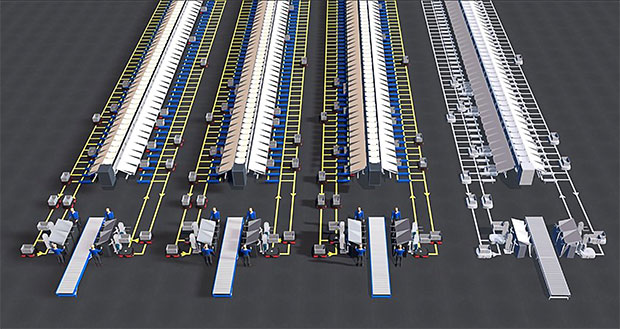FORTNA, a leading automation and software company for the full logistics value chain, has announced the launch of FORTNA OptiSweep, a robotic solution to automate the consolidation and transportation of small orders away from sortation systems in high-volume eCommerce and sortation distribution centres. This innovative solution automates what is typically a labour-intensive process by using Geek+ robots to collect orders from sorter divert locations and bring them to specially designed goods-to-person locations to deposit orders for bulk consolidation and outbound processes. FORTNA WCS™ software and its proprietary algorithms seamlessly orchestrate the workflow, managing the mobile robots and communicating with the sorter and consolidation stations to maximise efficiency and balance product flow.
 FORTNA OptiSweep brings an innovative, proven and flexible robotic technology to the sorter close-out process, replacing both manual operations and legacy technologies such as the bombay sorter. Traditionally, high-volume distribution centres use large linear and loop sorters to organise packages into categories, diverting them down appropriate chutes into destination-specific bags. These processes often have workers assigned to monitor specific destinations, physically remove items and walk them to a consolidation station for downstream processes. The FORTNA OptiSweep solution significantly reduces these labour requirements and provides ergonomic improvements. It eliminates the need for workers to bend and reach into bags to move items and substantially cuts the distance and time spent walking in the warehouse.
FORTNA OptiSweep brings an innovative, proven and flexible robotic technology to the sorter close-out process, replacing both manual operations and legacy technologies such as the bombay sorter. Traditionally, high-volume distribution centres use large linear and loop sorters to organise packages into categories, diverting them down appropriate chutes into destination-specific bags. These processes often have workers assigned to monitor specific destinations, physically remove items and walk them to a consolidation station for downstream processes. The FORTNA OptiSweep solution significantly reduces these labour requirements and provides ergonomic improvements. It eliminates the need for workers to bend and reach into bags to move items and substantially cuts the distance and time spent walking in the warehouse.
“Labour challenges are ubiquitous across supply chains, and this post-sorting process is a prime example, marked by frequent over- or understaffing,” stated Rob McKeel, CEO, FORTNA. “Businesses need automation solutions that provide consistent outcomes and can scale to match the spikes and dips of eCommerce. OptiSweep exhibits how FORTNA is merging robotic proficiency with unmatched design and implementation capabilities to effectively address issues related to labour dependency, variable throughput demands, capacity constraints and more.”





Comments are closed.